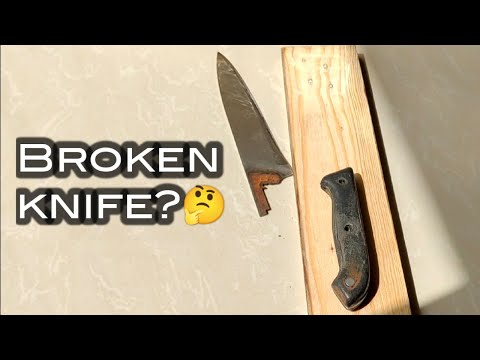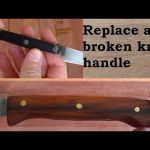
9eb622ed2e0e79a54e611eee37707ad5
Having a broken knife handle can be a major inconvenience, especially if it’s your favorite knife. Fortunately, it’s possible to repair a broken knife handle with a few simple tools and materials. In this article, we’ll discuss the steps you need to take to repair a broken knife handle and get your knife back in working order. We’ll also discuss the materials and tools you’ll need to complete the job. With the right knowledge and supplies, you can easily fix a broken knife handle and get back to using your favorite knife.
Can you repair a knife handle
Knives are essential tools in the kitchen, and a broken handle can make them unusable. Fortunately, it is possible to repair a knife handle, depending on the type of damage. Replacing a broken handle is the most common repair, and it is relatively easy to do. You will need a few tools and supplies, such as a drill, screws, and a new handle.
If the handle is cracked or chipped, you can repair it with epoxy. Clean the handle with a damp cloth and then apply the epoxy to the damaged area. Allow the epoxy to dry completely before using the knife. You may need to sand the handle to make it smooth again.
If the handle is loose, you can tighten it by removing the screws and adding a few drops of wood glue. Allow the glue to dry before replacing the screws. You may need to use a clamp to hold the handle in place while the glue dries.
If the handle is severely damaged, you may need to replace it. You can purchase a new handle from a hardware store or online. Make sure the handle is the same size and shape as the original. You will need to drill holes in the handle and attach it to the blade with screws.
Repairing a knife handle is not difficult, but it is important to take the necessary precautions. Make sure you use the right tools and supplies, and wear protective gear such as gloves and safety glasses. If you are not comfortable with the repair, it is best to take the knife to a professional.
What kind of glue do you use on a knife handle
When it comes to repairing a knife handle, the type of glue you use is important. The wrong type of glue can cause the handle to become brittle and break, or it can cause the handle to become loose and wobbly. To ensure that your knife handle is properly repaired, it is important to use the right type of glue.
Epoxy is one of the most popular types of glue used for knife handles. It is a strong adhesive that is resistant to water, heat, and chemicals. It is also very durable and can be used to repair a variety of materials, including wood, metal, and plastic. Epoxy is easy to use and can be found in most hardware stores.
Another type of glue that can be used on a knife handle is super glue. Super glue is a fast-drying adhesive that is great for quick repairs. It is also very strong and can be used to repair a variety of materials. However, it is not as durable as epoxy and should not be used for long-term repairs.
Finally, silicone glue is another option for repairing a knife handle. Silicone glue is a flexible adhesive that is resistant to water and heat. It is also very durable and can be used to repair a variety of materials. However, it is not as strong as epoxy or super glue and should not be used for long-term repairs.
When it comes to repairing a knife handle, it is important to use the right type of glue. Epoxy, super glue, and silicone glue are all good options for repairing a knife handle. However, it is important to choose the right type of glue for the job to ensure that your knife handle is properly repaired.
How do you bind a knife handle
Knives are essential tools for many tasks, from cutting food to whittling wood. To ensure that your knife is safe and secure, it is important to bind the handle properly. This article will explain the steps to binding a knife handle.
Step 1: Gather Materials
Before you begin, you will need to gather the necessary materials. You will need a knife, paracord, a lighter, and scissors. Paracord is a type of strong, lightweight rope that is often used for binding knife handles. It is available in a variety of colors and patterns.
Step 2: Measure the Paracord
Once you have the materials, you will need to measure the paracord. You will need enough paracord to wrap around the handle of the knife several times. Measure the paracord and cut it to the desired length.
Step 3: Begin Wrapping
Now you are ready to begin wrapping the paracord around the handle of the knife. Start at the base of the handle and wrap the paracord around the handle in a spiral pattern. Make sure to keep the wraps tight and even. As you wrap, you can adjust the tension of the paracord to ensure a secure fit.
Step 4: Secure the Paracord
Once you have wrapped the paracord around the handle, you will need to secure it. Use the lighter to melt the end of the paracord and press it against the handle. This will create a secure bond between the paracord and the handle.
Step 5: Trim the Paracord
Finally, you will need to trim the excess paracord. Use the scissors to trim the paracord close to the handle. Make sure not to cut too close, as this could cause the paracord to unravel.
Conclusion
Binding a knife handle is a simple process that can be done in a few easy steps. With the right materials and a bit of patience, you can ensure that your knife is secure and ready for use. So, grab your materials and get to binding!
What holds a handle on a knife
Knives are essential tools in the kitchen, and the handle is an important part of the knife. It is the part of the knife that you hold onto when using it, and it needs to be securely attached to the blade. There are several different methods used to hold a handle onto a knife, and each has its own advantages and disadvantages.
Screws
One of the most common methods of attaching a handle to a knife is with screws. This method is relatively simple and inexpensive, and it is easy to replace the handle if it becomes damaged. The downside of this method is that the screws can become loose over time, and the handle may need to be tightened periodically.
Rivets
Rivets are another popular method of attaching a handle to a knife. This method is more secure than screws, as the rivets are permanently attached to the blade. The downside of this method is that it is more difficult to replace the handle if it becomes damaged, as the rivets must be removed first.
Adhesives
Adhesives are also used to attach a handle to a knife. This method is relatively inexpensive and easy to use, but it is not as secure as screws or rivets. The handle may come loose over time, and it may need to be re-glued periodically.
Molding
Molding is a more permanent method of attaching a handle to a knife. The handle is molded directly onto the blade, and it is not easily removed. This method is more secure than screws, rivets, or adhesives, but it is also more expensive and time-consuming.
Conclusion
There are several different methods used to hold a handle onto a knife, and each has its own advantages and disadvantages. Screws are the most common method, but rivets, adhesives, and molding are also used. Ultimately, the best method for attaching a handle to a knife will depend on the type of knife and the user’s preferences.
We hope this article has been helpful in guiding you through the process of knife handle repair. We wish you the best of luck in fixing your broken handle and hope you have a successful repair!
Goodbye and thank you for reading!





